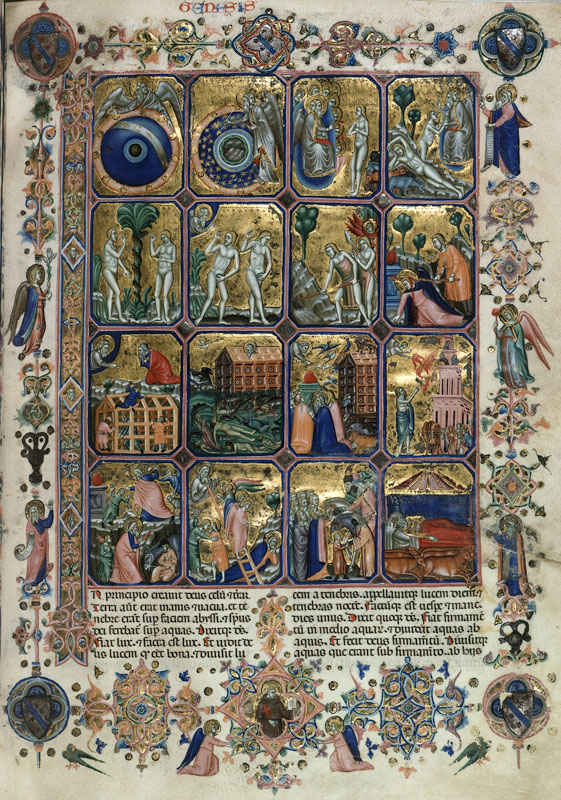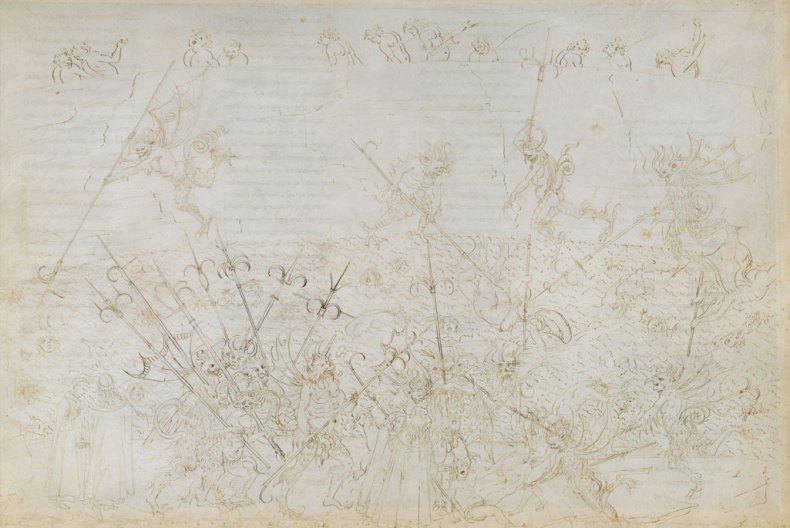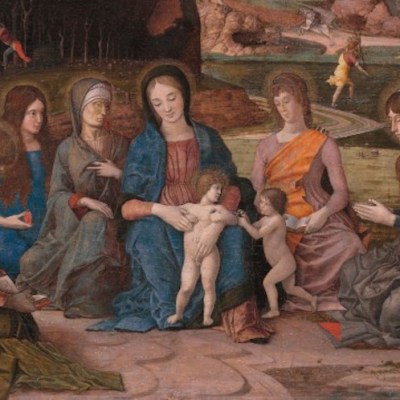‘Botticelli and Treasures from the Hamilton Collection’ is in just about every sense a small-scale show – a fact that brings wonders, and a few frustrations too. The works on display are uniformly stunning: with a selection of 30 of Botticelli’s illustrations for Dante’s Divine Comedy taking top billing, the show also features some of the most beautiful illuminated manuscripts produced in medieval Europe. The problem, of course, is that few things are more tantalising than a beautiful book kept in a vitrine. From pocket breviaries to the largest codex, every book is designed to be handled, to be held up to the light, and – most importantly of all – to have its pages turned. In terms of the seen and the unseen, even icebergs have better percentages than a manuscript under glass.
While the viewer’s attention is directed above all to the Botticelli drawings (long ago unbound and framed for gallery display), it is well worth lingering over the books on show – particularly with the aid of one of the magnifying glasses thoughtfully laid on by the gallery. The catalogue refers to the Botticelli series as the ‘jewel’ of the Hamilton collection, but that term seems a little misapplied in the context of the other manuscripts, with their luminous colours, gilding and trompe l’oeil expansions of the written page into other forms and fields.
Genesis in the so called Hamilton Bible, (c. 1350–60), Cristoforo Orimina. © Staatliche Museen zu Berlin, Kupferstichkabinett / Jörg P. Anders

The page displayed from a late 15th-century copy of Horace’s Carmina, illuminated by Giovanni Todeschino features an elaborate architectural border, decorated with painted pearls, rubies and sapphires. The text is flanked on one side by a legionary in a teal breastplate, his sword in a scarlet scabbard, and on the other by the figure of Caritas, breastfeeding two babies. The pedestals of the border lift the framed text high enough for the reader to see through to a miniature landscape beneath, with a carmine-robed scholar (the vita contemplativa) meeting a lapis-robed farmer (vita activa). A Milanese copy of Visconti’s De Paulo e Daria amanti from the same period sets one page of text into a wall, showing blue sky through its crumbling masonry. Another folio (shown only in the catalogue) features a fly crawling across the middle of the page, while apparently torn vellum gives way to a botanical miniature beneath. Knowing what must lie on other pages of these manuscripts, it’s hard not to spend the show gripped with envy, directed at the people who have lived with them across the centuries – above all the 10th Duke of Hamilton, into whose hands they all eventually passed.
Against the other manuscripts one could be forgiven for finding Botticelli’s Dante drawings a little underwhelming at first. Representatives of a grand, unfinished project, they are, unlike the other manuscripts in the exhibition, mostly colourless – something that the catalogue concedes gives them slightly less ‘wall power’ than they might otherwise have. Unfinished is, though, a relative term: Botticelli’s work on the project extended across two decades (c. 1480–1500), and despite their varying states of completion the drawings are little short of miraculous. While some, particularly in the later stages of Paradiso, are sparse, others – such as the illustration to Purgatorio X – teem with detail, all on a scale which makes the gallery magnifying glasses a must.
Punishment of the corrupt in the eighth circle (Divine Comedy, Inferno XXII) (c. 1481–95), Sandro Botticelli. © Staatliche Museen zu Berlin, Kupferstichkabinett / Philipp Allard

It goes without saying that Botticelli’s illustrations stand happily on their own, but they are also closely bound to the text of the poem in a way their separation from the original manuscript cannot undo. What is truly remarkable, and perhaps not quite brought out by the refreshingly straightforward gallery blurbs, is the closeness of Botticelli’s engagement with Dante. The poet’s own fastidious attention to physical detail – from wholesale bodily transformations to fleeting facial expressions – is mirrored in Botticelli’s drawings down to the tiniest level, as is his evocation of characters’ moods and personalities. In the illustration to Purgatorio III, Botticelli replicates precisely the successive stages of Virgil’s crestfallenness as he attempts to hide his confusion at how to enter Purgatory itself. Botticelli follows the two poets across the beach, until the scene culminates with Virgil’s sudden, falsely nonchalant relief as he takes up Dante’s suggestion, con libero piglio, and asks the advice of a group of saved souls ahead of them on the shore.
It is all at once beautifully composed, humorous, and utterly faithful to the text. And, like the other manuscripts on display, made me long to sit down and leaf through Botticelli’s Dante like the book it once was.
‘Botticelli and Treasures from the Hamilton Collection’ is at the Courtauld Gallery, London, until 15 May.



